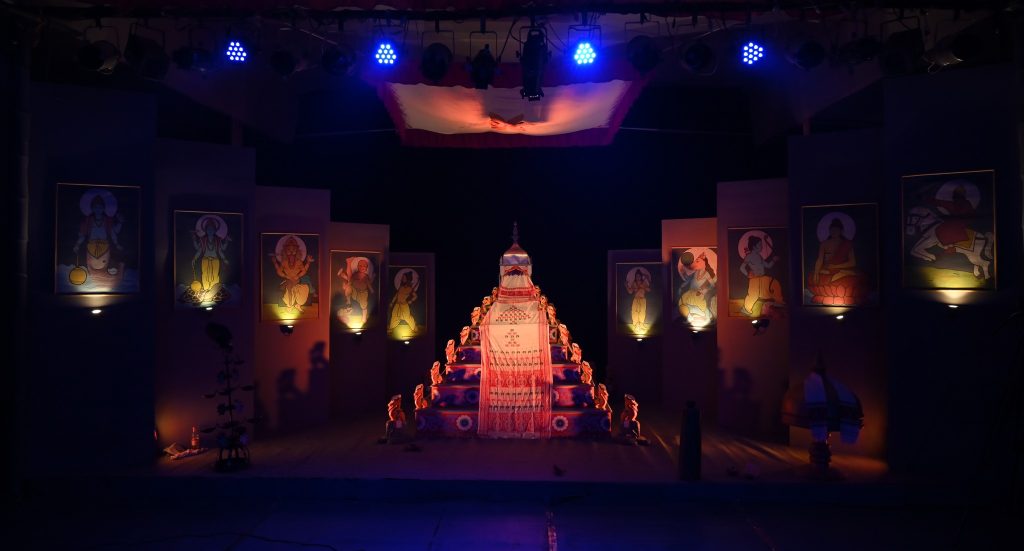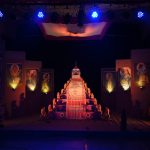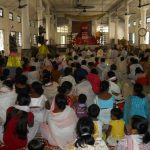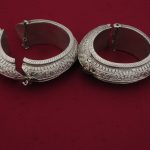What I propose to submit in this lecture is an analysis from my point of view about medieval Indian theatre, supported by evidence in the realm of different Indian traditions. I will certainly revise my views in the light of new elements, which come to my sight. I will have to analyse different traditions minutely so that I can assess the status of Ankiyā Bhāonā. So, it is a comparative analysis of medieval Indian theatre traditions.
Theatre is enactment of a play. The Indian theoreticians call it Bākyābhinaya. India has been a land of theatre since long ago. The Nātyashāstra was written in around second century BCE in this land. But if we consider the prose incantations in Yajur Veda, the history of Indian theatre will be about three millenniums old. Similarly, Sāma Veda also has such elements. The Sarat Sanat Kumāra Sambāda contained in the Chāndogya Upanishada of Sāma Veda is another example of dramatic dialogue. Since then, there have a lot of developments, the theatre movement picking up in the modern Indian languages too in the medieval period. Thus, while we had only Sanskrit theatre in ancient period, we had both Sanskrit, MIL and vernacular theatres since the medieval period. The Sanskrit theatre faced crisis of existence in absence of patronage. There was only a limited number of Sanskrit playwrights and Sanskrit plays in medieval period. These creations were by Vidyanath (1300 CE), Mokshaditya (1300 CE), Viswanath (1350 CE), Uddanda (1400 CE), Sesh Krishna (1600 CE), Nilakantha Dikshit (1650 CE), and Rambhadra Dikshit (1700 CE). The most prominent was however the play Bidagdha Mādhava by Rupa Goswami (1500 CE), who happened to be a disciple of Srimanta Sankaradeva.
Sanskrit theatre decayed into Uparupaka over time. Uparupakas are dramas of inferior class, comprising of music, dance drama and bodily gesticulation only; they highlight emotion and they present only a fragment of a story. The main types of Sanskrit Uparupakas are Nātikā, Trotaka, Gosthi, Sattaka, Nātyarāsaka, Prasthāna, Ullapya, Kāvya, Prekshānaka, Rasaka, Samlāpaka, Shrigādita, Shilpaka, Vilāsika, Durmilita, Prakaranika, Hallisa and Bhanika. All the types of Abhinaya are not present together in these. The Nātya element of Rupaka is missing in these. The Turko-Persian influence by the invaders in medieval period was responsible for this decay.
Srimanta Sankaradeva was pioneer in MIL theatre, as he launched this movement with his epoch-making play Chihna-Yātrā in 1468 CE. This was a watershed of Indian theatre movement. The plays authored by Srimanta Sankaradeva came to be known as Ankiyā play and the theatre form initiated by the enactment of these plays was known as Ankiyā Bhāonā. This nomenclature is also unique in all Indian theatre as the other Indian theatres did not have separate nomenclature for the play and the performance.
During the medieval period, we had Sanskrit theatre as well as other MIL theatres, which may be described as Terukkuttu and Kattaikkuttu from Tamil Nadu, Kutiyattam and Ramanattam from Kerala, Yakshagāna from Karnataka, Kuchipudi from Andhra Pradesh, Chāu from Eastern India, Ojāpāli from Assam, Yātrā from Bengal and Odisha, Bhavāi from Gujarat, Rāsa Lilā from Manipur, Gujarat and Mathura, Rāma Lilā and Nautanki from North India, Tamāshā from Maharashtra, Kushān gān from Assam, and Swang from Haryana.
Kathak from Uttar Pradesh, Odissi from Odisha, and Kathākali from Kerala are not counted as theatre by the scholars as these are merely dance forms. The scriptures call them as Padārthābhinaya, meaning acting of verse. The essential elements of theatre are not present there. In order to be recognised as theatre, there must be story-telling in it. Kathak, Odissi and Kathākali are only dance forms, just like Sattriyā dance. While Sattriyā dance is there in Ankiyā Bhāonā, there are also additional elements like Suttradhāra, who integrates different dance elements to a complete narrative presented under his anchoring. Similarly, Kushān gān, practiced in western Assam also has to be left out as it had only dance and songs, no presentation of narrative by actors.
Therefore, the Ankiyā Bhāonā has to be compared with Uparupaka, Kutiyattam, Ramanattam, Yakshagāna, Kuchipudi, Chāu, Ojāpāli, Yātrā, Bhavāi, Rāsa Lilā, Rāma Lilā, Nautanki, Terukkuttu, Kattaikkuttu, Tamāshā and Swang for any comparative study.
Among these performing art forms, Ramanattam, Chāu, and Kuchipudi are forms of dance drama. These do not have dialogues as in full-fledged theatre. The Sanskrit Uparupakas were also merely dance compositions, with only a fragment of a story, thus qualifying for the category of dance drama only. All the components of Abhinaya are not present in it, only some part of it is present. The Kathākali tradition of Andhra, Karnataka, Tamil and Malayalam areas is one such Uparupaka; the Vāchikābhinaya is absent here. Therefore, all these art forms do not come into our comparative analysis of theatre.
So, what we are left with, are Kutiyattam, Yakshagāna, Ojāpāli, Yātrā, RāsaLilā, Rāma Lilā, Nautanki, Terukkuttu, Kattaikkuttu, Tamāshā, Bhavāi and Swang. If we need to assess the status of Ankiyā Bhāonā in medieval Indian theatres, we have to make comparison with these forms of theatre.
Among the above, Nautanki is a musical composition. It is of the nature of opera, not a full-fledged theatre. Tamāshā was created for the amusement of the Mughal army and these were of gross taste. Erotic and boisterous in nature, these lacked the characteristics of theatre. It contains more dance and music than drama. The dramatic elements were added only in the 19th century when people refined this art form. In the medieval times it was certainly not qualified to be termed as theatre.
Kutiyattam retains the elements of Sanskrit theatre from ancient times. In fact, it is the only surviving Sanskrit theatre. It was not developed in the medieval times. Kutiyattam or Koodiyattam performances are generally lengthy, spread over several nights. Sometimes it was held for up to forty days, making it a festival rather than a drama. It requires at least six days holding it properly. There are three parts in these performances. These are Purappadu, Nirvahanam, and Kutiyattam. These are Nritta, Abhinaya and the main drama respectively. In the first two parts, there is solo acting, while the last part has several characters. Dialogues are in verse, delivered in Sanskrit. The Kutiyattam performance is made on the basis of a part of some Sanskrit play.
Yakshagāna from Karnataka is a theatrical performance with songs, dance and dialogues. It has most of the ingredients required in theatre like costume, headgear, make-up, and mask. But songs, dance and dialogues are often improvised, which is not a classical feature. Thus, it remains a folk-art form. The first available written text of this art form is of 1556 CE, which is much later than that of Ankiyā Bhāonā. Moreover, the dialogues of Yakshagāna were in verse unlike the prose dialogue of Ankiyā Bhāonā. Yakshagāna is more like a Ballet, rather than theatre. Eventually it has to be categorised as dance drama only.
Terukkuttu is a form of street theatre, while Kattaikkuttu is a rural theatre, both practiced in Tamil Nadu. While Terukkuttu is a mobile performance in procession, Kattaikkuttu is performed at a fixed place. There are songs and dances. Dialogues are delivered in both verse and prose. The themes are taken from Mahābhārata. But these are performed during the Mariyamman festival only, when the mother goddess is worshipped. So, these are only periodic festivals, not regular theatre or Bākyābhinaya. Moreover, these are only two to three centuries old. Even the modern harmonium is used in these, in addition to Mridangam. They did not exist at the time when Ankiyā Bhāonā evolved. These two art forms however have potential to be known as Indian theatre, if they are performed individually, outside the Mariyamman festival, and if modern instruments are avoided.
In Bhavāi and Swang, there is not much movement in the performance. Bhavāi is only a form of Swang. These are only story-telling, dance and music. The actors engage in mimicry. Dialogues are improvised, not prepared earlier. So, it is difficult to include it in regular format of theatre. It cannot be counted as full-fledged theatre. It is prevalent in regions like Rajasthan, Haryana, Uttar Pradesh and the Malwa region of Madhya Pradesh, while Bhavāi is prevalent in Gujarat. If we compare them with Ankiyā Bhāonā, we find that Swang or Bhavāi is missing in proper text for the play as well as grammar for hand and foot movements. All these make Swang and Bhavāi folk elements, in comparison with the classical nature of Ankiyā Bhāonā.
In case of Yātrā and Rāsa Lilā, we would venture to say that the derivatives stand no comparison with the original element. Both Yātrā and Rāsa Lilā were derived from Ankiyā Bhāonā. The Yātrā movement of Odisha and Bengal developed under the impact of Ankiyā Bhāonā; the performance of the Ankiyā play Kāliya Damana in that region led to the creation of the Yātrā movement. Starting with sixteenth century, Ankiyā Bhāonā of Srimanta Sankaradeva’s Kāliya Damana became so popular in Odisha and Bengal that many derivatives of that genre came up in the region under the name Yātrā. Over time, Yātrā picked up secular themes also.
Similarly, the Rāsa Lilā of Manipur was started by the Gāyan Bāyan taken from Assam by the Manipur king Bhagyachandra or Ching-Thang Khomba (born 1740 CE), who ruled Manipur for forty years from 1759-1761 and 1763-1798. He was impressed by the performance of Rāvana Badha, a play enacted in the style of Ankiyā Bhāonā in his honour by his son-in-law, Ahom king Rajeswar Singha. Bhagyachandra introduced the Rāsa Lilā in Manipur with the assistance of Gāyan Bāyan. But Gāyan Bāyan was only a dance component of the Ankiyā Bhāonā. The Rāsa Lilā of Manipur, developed with the assistance of Gāyan Bāyan of Ankiyā Bhāonā naturally had those features only, nothing beyond that. It did not become full-fledged theatre. The Rāsa Lilā of Manipur borrowed heavily from Sattriyā Nritya; it is evident in their costume, movement like Dherāpāk, dance items like Chāli Nritya and the Tālas used in the whole performance. All the Tālas of Manipur, starting with the prefix Tekhāo are derived from the Tālas of Sattriyā Nritya.
This analysis applies to Rāsa Lilā of Mathura also. Moreover, there is no dialogue as in Ankiyā Bhāonā, but only dance and songs in Rāsa Lilā. Therefore, Rāsa Lilā can be categorised as a dance drama, not a full-fledged theatre. Gujarat also developed Rāsa Lilā. It is called Dāndiyā Rāsa. This developed at a later period than Gāyan Bāyan. The modern Garbā dance of that region is a derivative of that Dāndiyā Rāsa tradition. Moreover, it is only a dance, no theatrical element is there. So, it stands no comparison with Ankiyā Bhāonā.
The Rāma Lilā used to be performed mainly in regions like Uttar Pradesh, Uttarakhand, Bihar and Madhya Pradesh; but now it has become very popular in many parts of the country. Though the format is that of dance drama, there are dialogues in verse in this theatre. Improvisation is also allowed and even audience allowed becoming part of it. Thus, there is no fixed grammar in this theatre, making it fall short of classical in nature. Another aspect of Rāma Lilā is that it is more of a festival than a single performance. Rāma Lilā is often held for ten to thirty days at a stretch, observed during the Navrātri of autumn season. So, it would be more appropriate to term it as a festival, just like Bihu is a festival in Assam. Just as Bihu is observed in spring, is observed during Navrātri. But a theatre is not confined to the period of a particular season or festival. That is why we are shy of calling Rāma Lilā as a theatre; we deem it as a popular festival of India.
Coming to Ojāpāli, it was a narrative in verse, accompanied with soft foot movements. The Ojā maintains a regular dramatic movement and a few colleagues known as Pāli maintain steps in tandem with him. The Ojāpāli has many uniqueness; its narratives are in the Gāthā type, styled after the contents of the Sāma Veda. The topics are mainly on the epics. In Vyāh Ojāpāli, the Ojā kept a Braja (or Mudurā) in his hand to arouse the deity by inviting divine power; this is indicative of the Vedic lineage of this art form. This arousal of deity is like Jāgar, a ritualistic music tradition practiced mostly in Garhwal and Kumaon since early tenth century. The tradition is however older in Assam, going back to the fourth century.
There are different variations of Ojāpāli. Among them Vyāh Ojāpāli, Rāmāyan Ojāpāli, Bhāirā Ojāpāli, Durgābari Ojāpāli, Sattriyā Ojāpāli, Naganyā Ojāpāli, Pānchāli Ojāpāli and Dulari Ojāpāli take their narratives from the epics. On the other hand, Sukanāni Ojāpāli, Bishahar iOjāpāli, Māregān, Padma-purānar-gān and Tukuriyā Ojāpāli take narratives from outside the epics. All members of the Ojāpāli team wear white dresses. Some of these Ojāpāli types like Sattriyā Ojāpāli and Naganyā Ojāpāli have been developed in later period. Influence of Ankiyā Bhāonā on them is very distinct. So, Ojāpāli and Ankiyā Bhāonā influenced each other.
The narration in Ojāpāli is done in verse and there is no given text for the dialogues. Thus, it could not rise to the stature of theatre. An old tradition of Assam, Ojāpāli has therefore to be considered as a distinct folk art-form in absence of strict grammar as well as textual script. Of course, the Vyāh Ojāpāli follows a partial grammar, which covers Rāgas, rhythm, hand gestures, and foot works. The distinctive features of Ojāpāli make it a unique form of semi-theatrical performance, though not a full-fledged theatre. It may be compared to the Greek Ballad, which sing the stories of the epics – Iliad, Odyssey and Enid. Moreover, Ojāpāli left indelible mark on the Ankiyā Bhāonā. The character of the Suttradhāra in Ankiyā Bhāonā was certainly derived from the Ojā of Ojāpāli. Unlike the Suttradhāra of Sanskrit theatre, the Suttradhāra of Ankiyā Bhāonā remains in the arena of acting all throughout the play, just like the Ojā of Ojāpāli.
In view of all these, it is abundantly clear that the Ankiyā Bhāonā remains the sole format of theatre from medieval times, which is fully classical, equipped with grammar. It is performed in any time of the year. The only comparison may be made with Kutiyattam. But in Kutiyattam, dialogues are in Sanskrit and in verse, that took a tradition continued from ancient times. So, the Ankiyā Bhāonā is the only theatre where dialogues were delivered in prose and the only theatre in proper sense of the term in all modern Indian languages as well as vernacular languages. It is also the only full-fledged theatre form developed in the medieval times.
Scripts of several Ankiyā plays have been recovered till now. These are Patni Prasāda, Kāliya Damana, Keli Gopāla, Rukmini Harana, Pārijāta Harana, and Sri Rāma Vijaya. Srimanta Sankaradeva composed and enacted another play named Janma Yātrā when he was residing at Patbausi, according to the hagiographer Ramcharan Thakur. The saint composed that play after returning from his second pilgrimage. The script of the play Janma Yātrā is however not available now. The Vrindavani cloth which was woven later, incorporating the incidents in Sri Krishna’s life starting from birth till the killing of king Kangsa was a textile art form of the Janma Yātrā play only. Unfortunately, the Vrindavani cloth has been displaced; a part of it now remains in Guimet Museum of Paris. Other two plays authored by Srimanta Sankaradeva were Gopi Uddhava Sambāda and Kangsa Badha. The script of the first was gutted in fire, while the second was lost. We can therefore list the ten plays of Srimanta Sankaradeva as Chihna Yātrā, Patni Prasāda, Kāliya Damana, Keli Gopāla, Rukmini Harana, Pārijata Harana, Janma Yātra, Gopi Uddhava Sambāda, Kangsa Badha and Sri Rāma Vijaya.
Srimanta Sankaradeva set several world records with his play Chihna-Yātrā. He used drop-scenes in it for the first time in the world. Also, he constructed stages in higher levels than that of the audience. A seven-layer stage was constructed for this play, which was yet another innovative experiment in the entire world. It was also the first play in all modern Indian languages. The second play of the saint litterateur, Patni Prasāda also experimented another innovation. The playwright introduced the characters of teenage boys in this play, which was the first time in any Indian play. Before this, only adult characters were included in the plays. So, the play Patni Prasāda deserves a distinctive place in the annals of Indian drama.
Srimanta Sankaradeva did a noteworthy act by composing these Ankiyā plays. This was the introduction of prose style in Assamese language and literature. All literary works till the time of Srimanta Sankaradeva had been composed in verse. It was he who used prose for the first time in the Ankiyā plays. So, the prose style came into being in the Assamese literature with these Ankiyā plays only. This prose was innovative and different from the colloquial prose form quite as expected from a litterateur of high calibre. Unfortunately, the script of the first ever Ankiyā play, Chihna-Yātrā is not available. So, we will have to consider the second play, Patni Prasāda as the first available instance of prose form in Assamese literature. With rendering of these prose dialogues, Ankiyā Bhāonā became the first Indian theatre in all modern Indian languages.
The Maithili plays that came later were completely influenced by the Ankiyā plays of Srimanta Sankaradeva. Two Maithili playwrights influenced by the saint were Govinda, who composed his plays around 1640 CE and Umapati, who was a playwright of the transition period between the seventeenth and the eighteenth century. The Maithili playwrights derived the concept and materials for their Harana plays from the Ankiyā plays. The Harana plays like Ushā Harana, Rukmini Harana, and Umapati’s Pārijata Harana are vivid examples of this. The influence of Ankiyā plays in these Maithili plays is seen in the nomenclature of the plays, enactment of the play during night, enactment at a regular place like in Bhāonā, entry of the Suttradhāra after the recital of Nāndi like in Bhāonā, costume, headgear etc.
The characteristics of Ankiyā Bhāonā make it stand out among all forms of Indian theatre, even the Sanskrit theatre. The scenes which had been banned in Sanskrit theatre, like eating, killing, battle etc, were accepted in Ankiyā Bhāonā. It was the first Indian theatre, where the audience were given sermon on an ideology, making the entire theatre an instrument of proselytization. There are numerous metaphorical elements in this theatre, like the Pāmori cloth, āriyā, and the costume of the Suttradhāra. The Pāmori cloth is lifted when divine characters enter, signifying removal of illusion; this is completely white, unlike the coloured cloth used in Kuchipudi, Kutiyattam, Yakshagāna. Another feature is that Ankiyā Bhāonā launched a completely new instrument, the drum known as Khol. No other Indian theatre had introduced such an innovation. Moreover, it was the only form of Indian theatre, which became the launching pad for a new school of dance and music; it was with the Ankiyā Bhāonā that Sattriyā dance and Sankari Sangeet came into being.
All these analyses make Srimanta Sankaradeva the pioneer of modern Indian language theatre as well as vernacular theatre, and a leader of Indian theatre movement. Ankiyā Bhāonā was the only full-fledged theatre in the medieval India, and the first in the modern Indian languages. Ankiyā Bhāonā has shaped different cultural traditions in different parts of India. For example, Terukkuttu and Kattaikkuttu of Tamil Nadu, which have prose dialogues, evolved after the Ankiyā Bhāonā. Kattaikkuttu is even performed in open rectangular arena, where audience sit on three sides, just like in Ankiyā Bhāonā. The Ankiyā Bhāonā had its impact on the Maithili plays of 17th century and Braja Bhāsā plays of 18th century also. Finally, the Hindi plays evolved in the 19th century under the initiative of mainly Bharatendu Harishchandra (1850-1885 CE); the Hindi language evolved from the language of the Ankiyā plays only. Even a major Sanskrit play of this period Bidagdha Mādhava was authored by Rupa Goswami, a disciple of Srimanta Sankaradeva. Thus, the Ankiyā plays and their enactment, the Ankiyā Bhāonā have shaped and influenced the Indian drama movement and Indian theatre since the medieval times.
[Lecture delivered in the 14th Ankiya Bhaona Samaroh organised by Sattriya Kendra of Sangeet Natak Akademi at Sipajhar on 20th March, 2024]




